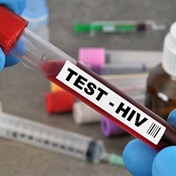Their presentation, on the opening day of the world Aids conference, came under challenge from some delegates, who feared it could encourage unsafe sex, but most attending the debate seemed to give a warm welcome.
In January, Switzerland’s Federal Commission for HIV/Aids issued a report on so-called "discordant" couples – couples in which one individual has HIV while the other does not.
The panel said that such couples need not use a condom provided the infected partner regularly followed antiretroviral therapy and had no genital infections. In addition, the level of human immunodeficiency virus (HIV) in his or her blood had to be below detectable levels – a threshold of 40 viruses per millilitre of blood – for the six previous months at least.
'Message too broad'
In a debate just ahead of the 17th International Aids Conference, panel member Pietro Vernazza said there was "no documented case" of infection among discordant couples who fell in this category, and characterised the risk of transmission as "negligible."
He also pointed out that sex without using a condom – the sole recommended method for safe sex – was an "issue of pleasure." Health experts, policymakers and field workers attended the event, and some openly challenged the findings.
"This message is too broad. People will think it’s OK not to use condoms any more," said Rolande Hodel, who heads a non-govenmental illilitern called AidsfreeAfrica.
Nancy Padian, a researcher at North Carolina University, said the report was of "limited applicability" in poor countries and had "a large potential for doing more harm than good."
But Nikos Dedes, with the European Aids Treatment Group, congratulated the Swiss team, saying the report "lifts the fear of being a threat to partners" and helped regain the right to the "uninhibited experience of sexual pleasure."
Research hints at fourfold increase in infections
In a paper published by The Lancet last month, epidemiologists led by David Wilson of the University of New South Wales in Sydney used a simple mathematical model to estimate the cumulative risk of transmission if the infected partner had only 10 viruses per millilitre of blood.
Their model is based on the assumption that each couple has 100 unprotected sexual encounters a year. If so, an HIV-negative male would face a 0.22-percent risk of infection each year from an HIV-positive woman.
The risk for an uninfected female from an infected male would be 0.43-percent annually. The risk in gay relationships would be far higher – in male-to-male anal transmission the probability of infection would be 4.3 percent per year.
Extrapolated over a decade, this would translate into a fourfold increase in Aids infections among discordant couples, compared with current rates of condom use.
"If the claim of non-infectiousness in effectively treated patients was widely accepted, and condom use subsequently declined, then there is the potential for substantial increases in HIV incidence," the study warned.
The antiretroviral drug "cocktail," introduced in 1996, has been a lifesaver for many people with HIV.
But it is not a cure, for it only suppresses viral levels, rather than eradicate the pathogen completely. If the drugs are stopped, the virus rebounds.
Background on conference
Meanwhile, at the conference, leaders in the fight against Aids have pleaded for the world to keep up its momentum against the disease and step up funding for HIV treatment and prevention.
"It's the first time in the history of this epidemic that on a large scale we have results," Peter Piot, executive director of the UN agency UNAIDS, told a press conference at the opening of a six-day conference. "We are entering into a new phase, with new challenges, challenges of sustainability," Piot said, pointing to the three million people in developing countries who are now on antiretroviral therapy.
Close to 22 000 scientists, policymakers and field workers were expected to attend, making it the second largest conference in the 27-year history of the disease, and the biggest in a developing country.
The gathering, held every two years, coincides with a relative lull in the long fight against the disease, marked by belated progress to bring antiretrovirals to badly-hit poor nations. The theme, "Universal Action NOW," reflects an appeal to political leaders to maintain this effort, which is shadowed by worries about another money crunch as the cost of treatment spirals.
Positive and negative news expected
Questions have been raised in books and commentaries in medical journals as to whether the billions spent on Aids could be better allocated to combating malaria and other diseases that are less visible, but also lethal.
Insiders said they did not expect any breakthrough announcement in the arena of drugs, and braced for confirmation that the quest for a vaccine and an HIV-thwarting vaginal gel was mired in setbacks.
More positively, though, evidence has emerged that male circumcision can help prevent HIV infection among men - a finding of great significance in southern Africa, the epicentre of the pandemic. – (Sapa, August 2008)
Read more:
HIV threatening governments
Global Aids epidemic stable: UN




 Publications
Publications
 Partners
Partners










